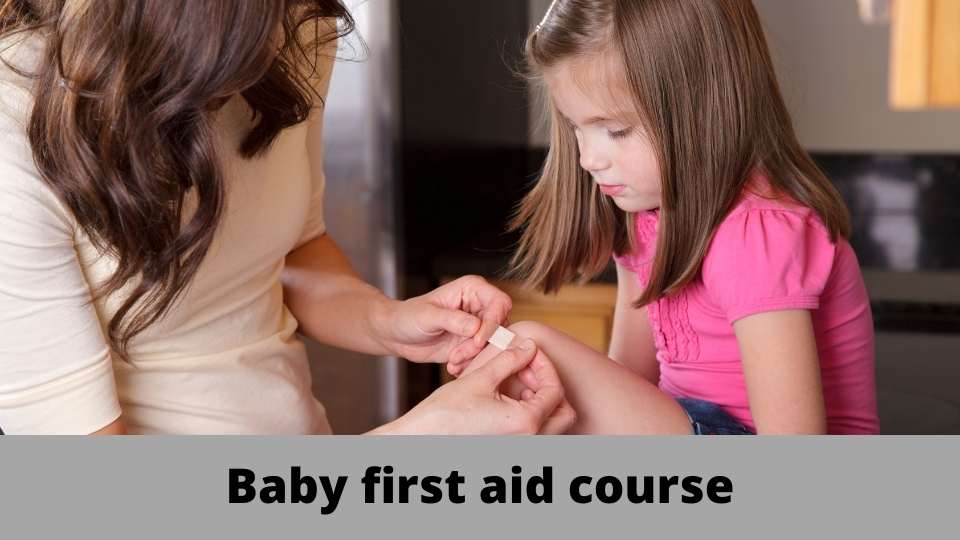Introduction
Taking seminars in newborn cardiopulmonary resuscitation and baby first aid is one of the finest methods for new parents, grandparents, and babysitters to get ready for the unexpected (CPR). Knowing what to do in an emergency can enable you to act calmly, swiftly think things through, and confidently so that you can assist your child. Here’s how to deal with some of the most typical illnesses and accidents that strike kids under a year old.
What is First Aid?
“First aid” refers to providing immediate assistance to someone who has been hurt, been in an accident, or has a medical emergency.
First aid is meant to keep someone alive, shield them from more harm, and do what you can to aid in their recovery whether they are a baby, child, or adult in need of care.
What age is an infant (baby) for the purposes of first aid?
The optimal range for an infant’s age is from birth to one year old.
What do if the baby chokes?
Risky foods including almonds, entire grapes, hot dogs, and popcorn can obstruct a baby’s airway. If you can see the object, try to get rid of it. However, avoid poking it because that could push it further down and make it more difficult to get rid of. When a baby is choking, you can tell because they are unable to cry, cough, make sounds, or breathe. When a baby is choking, you need to:
- Lay your baby face down on your thigh, with your hand supporting their head and their head lower than their bottom. Use the heel of one hand, in the space between their shoulder blades, to deliver up to five hardback punches.
- Turn the infant over so they are facing up and perform up to five chest thrusts if back blows are ineffective in removing the obstruction. Put two fingers right below their nipples in the center of their chest. Push downward firmly up to five times.
- If the obstruction does not move, contact emergency services. And while you wait for the ambulance, keep repeating cycles of back blows and chest thrusts until the obstruction is moved, assistance is received, or the infant loses consciousness.
How do you give CPR to an infant?
CPR is one of those things that everyone should know how to do, even if they hope they’ll never need it. This is especially true for parents and other caregivers because CPR may be able to save the life of your child or newborn.
Unfortunately, because the techniques are different, having adult CPR certification does not immediately allow you to conduct CPR on children or infants.
Before Performing Child & Baby CPR
- Assess the situation’s safety, establish an initial opinion, get parental or guardian approval, and put on personal protective equipment (PPE).
- Check the toddler or newborn for responsiveness if they seem to be unresponsive (shout-tap-shout).
- Use the baby’s name, if you know it, to shout to grab the baby’s attention. Check for breathing, life-threatening bleeding, or any other obvious life-threatening conditions while tapping the bottom of the infant’s foot and shouting again if they don’t reply.
Performing Child & Baby CPR
Step #1
Place the child or infant on their back on a stable, flat surface.
Kneel beside a child.
When holding a baby, place your hips at a little angle as you stand or kneel by their side.
Step #2
- Performing 30 compressions
- With your other hand on top and your fingers interlaced and off the child’s chest, place the heel of one hand in the center of the child’s chest.
- Lock your elbows and place your shoulders directly above your hands.
- maintain straight arms
- Push down vigorously and swiftly at a pace of 100–120 per minute, around 2 inches.
- After each compression, allow the chest to revert to its natural posture.
- Use a one-handed CPR technique when treating a young child.
- Put the heel of one hand on the child’s chest in the middle.
- Push down vigorously and swiftly at a pace of 100–120 per minute, around 2 inches.
- For a baby, place both thumbs (side-by-side) on the center of the baby’s chest, just below the nipple line
- Use the other fingers to encircle the baby’s chest toward the back, providing support
- Push down quickly and forcefully with both thumbs at the same time, going between 100 and 120 inches per minute.
- After each compression, let the chest return to its natural posture.
- Alternately, apply the two-finger method to a baby.
- Use two fingers in the center of the chest, parallel to the chest.
- If you can’t reach a depth of 1 12 inches for a baby, think about employing the one-hand approach.
Step #3
- Take two breaths.
- For a child, use the head-tilt/chin-lift approach to widen the airway to a position just past neutral.
- Use the head-tilt/chin-lift technique on an infant to expand the airway to a neutral position.
- Blow for approximately one second into the baby’s or child’s mouth.
- Make sure the chest rises with each breath.
- Before taking a breath, let the previous one expires.
- If the chest does not lift with the initial breath, tilt the head and check the seal before taking a second breath. If the chest does not lift with the second breath, something might be obstructing the airway.
What to expect from a baby first aid course?
Topics covered include:
- CPR
- Choking
- Bumps
- Burns
- Breaks
- Bleeding
- Febrile seizures
- Meningitis Awareness
Bottom Line
The Baby First Aid course equips participants with the knowledge necessary to recognize and care for a variety of first aid, breathing, and cardiac emergencies involving children and babies. Nursing Revalidation provides the best CPD accredited online First Aid Course.


